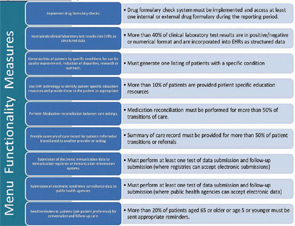
The Centers for Medicare and Medicaid Services’ (CMS’) Electronic Health Record (EHR) Incentive Program—Meaningful Use—requires that eligible providers participating in the incentive program successfully demonstrate meaningful use of the EHR system by reporting on a set of core and menu functional objectives to qualify for incentive payments of up to $44,000.
If you want to earn the incentive payment, it is imperative to review and fully understand the objectives as well as how and in what form the objectives are measured. Simply reviewing a list of Meaningful Use objectives and then working from there will not lead to success. The devil is in the details of what really needs to be done to meet those objectives. Work with your EHR vendor to verify that the appropriate processes for data entry are in place so that your EHR system can measure and report in a way that truly meets the measure and proves to CMS that you are a meaningful user of the EHR.
Understanding the Measures
Each of the Stage 1 objectives for Meaningful Use has an associated measure to gauge compliance and guide reporting (see Figure 1, right, and Figure 2 p. 20). These measures include specific terminology that clarifies how the objectives will be measured and the threshold that you must meet to be considered successful and qualify for incentive payments.
Among these is the concept of a “unique” patient. Many measures are based on counting data entered into the EHR or actions taken based on unique patients. A unique patient is one that is seen by the eligible provider more than once during the EHR reporting period. When a measure is based on unique patients, for the purposes of measurement calculation, that patient is only counted once in the denominator population for the measure regardless of the number of visits that patient had during the reporting period. For example, when the calculation in your first payment year (reporting year refers to the first year the eligible professional [EP] submits for payment, regardless of the calendar year, and is a 90-day period) is performed for the computerized physician order entry objective, the EHR system will review all the patients whom you have seen at least twice during that 90-day period and will count each patient, not each visit, once.
Each measure will be assessed and reported based on a percentage or a yes/no attestation. Many of the core objectives require measures reported according to a specified numerator, denominator, and exclusions (if relevant). The denominator identifies all the eligible cases for a measure, and the numerator describes an outcome or action relevant to that denominator population—most often the number of activities or functions performed using an EHR (see Figure 3, below right).
